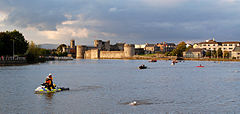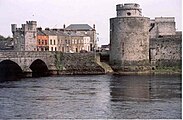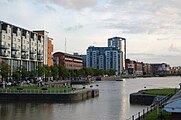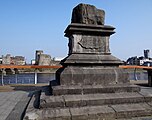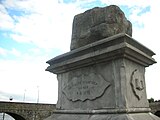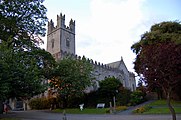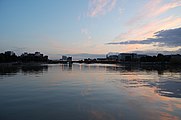Limerick: Difference between revisions
No edit summary |
|||
| (One intermediate revision by one other user not shown) | |||
| Line 3: | Line 3: | ||
|irish=Luimneach | |irish=Luimneach | ||
|county=County Limerick | |county=County Limerick | ||
|picture= | |picture=LIMERICKCOLLAGE.jpg | ||
|picture caption= | |picture caption=Montage of Limerick | ||
|latitude=52.6653 | |latitude=52.6653 | ||
|longitude=-8.6238 | |longitude=-8.6238 | ||
| Line 83: | Line 83: | ||
===Basketball=== | ===Basketball=== | ||
Similar to the rest of Ireland, basketball was a very popular sport in Limerick during the 1970s and 1980s, with up to four divisions in the men's and women's local leagues. It suffered a decline during the 1990s culminating in the complete demise of local league basketball in the city and surrounding areas. The main clubs in the city were St | Similar to the rest of Ireland, basketball was a very popular sport in Limerick during the 1970s and 1980s, with up to four divisions in the men's and women's local leagues. It suffered a decline during the 1990s culminating in the complete demise of local league basketball in the city and surrounding areas. The main clubs in the city were St Colm's and Marathon with St Colm's in particular having a long history in the National Leagues. There has been somewhat of a revival in basketball in the city in recent years, particularly at underage level. | ||
Limerick is currently represented in the [[Basketball Ireland|National Leagues]] by the men's UL Eagles team and the women's UL Aughinish team. They both play their home games at the 2,500 capacity University Arena at the University of Limerick. There are a number of other teams at school and club level, including St | Limerick is currently represented in the [[Basketball Ireland|National Leagues]] by the men's UL Eagles team and the women's UL Aughinish team. They both play their home games at the 2,500 capacity University Arena at the University of Limerick. There are a number of other teams at school and club level, including St Colm's, Limerick Lakers, Taste of Europe, Limerick Celtic and [[Limerick Lions]]. | ||
===Cricket=== | ===Cricket=== | ||
| Line 98: | Line 98: | ||
Limerick won the first [[All-Ireland Senior Football Championship]] in 1887 when represented by the city's Commercials club and repeated the feat in 1896. Since then, the game has lived mostly in the shadow of hurling but a resurgence in 2000 saw the county win its first Munster Under-21 title and has since reached three Munster Senior finals. Monaleen (Móin a'Lín), Claughaun (Clochán) and Mungret (Mungairit) play football at the senior grade. Saint Patrick's (Naomh Pádraig) and [[Na Piarsaigh GAA (Limerick)|Na Piarsaigh]] are at intermediate level and Milford (Áth an Mhuilinn), Abbey Sarsfields (Sáirséalaigh na Mainstreach) and Ballinacurra Gaels (Gaeil Bhaile na Cora) play at junior level. | Limerick won the first [[All-Ireland Senior Football Championship]] in 1887 when represented by the city's Commercials club and repeated the feat in 1896. Since then, the game has lived mostly in the shadow of hurling but a resurgence in 2000 saw the county win its first Munster Under-21 title and has since reached three Munster Senior finals. Monaleen (Móin a'Lín), Claughaun (Clochán) and Mungret (Mungairit) play football at the senior grade. Saint Patrick's (Naomh Pádraig) and [[Na Piarsaigh GAA (Limerick)|Na Piarsaigh]] are at intermediate level and Milford (Áth an Mhuilinn), Abbey Sarsfields (Sáirséalaigh na Mainstreach) and Ballinacurra Gaels (Gaeil Bhaile na Cora) play at junior level. | ||
A number of secondary school's compete in the [[Dr. Harty Cup]], which is the Munster Colleges Hurling Championship. Limerick CBS has won the cup on 10 occasions, including four in a row from 1964 to 1967 and most recently in 1993. The school also won the [[Dr. Croke Cup]], the All-Ireland Colleges Hurling Championship, on two occasions, in 1964 and 1966. Ardscoil Rís has won the championship on two occasions, in 2010 and 2011 and St | A number of secondary school's compete in the [[Dr. Harty Cup]], which is the Munster Colleges Hurling Championship. Limerick CBS has won the cup on 10 occasions, including four in a row from 1964 to 1967 and most recently in 1993. The school also won the [[Dr. Croke Cup]], the All-Ireland Colleges Hurling Championship, on two occasions, in 1964 and 1966. Ardscoil Rís has won the championship on two occasions, in 2010 and 2011 and St Munchin's College won it once, in 1922. | ||
Both the University of Limerick (UL) and Limerick Institute of Technology (LIT) have been successful in [[Fitzgibbon Cup|The Fitzgibbon Cup]], the All-Ireland Higher Education Hurling Championship. UL first won the championship in 1989 and have won it four times in all. LIT's two wins came in 2005 and 2007. Both of the colleges met in the final in 2011, with UL scoring an injury-time goal to win.<ref>[http://www.sportsnewsireland.com/gaa/fitzgibbon-cup-live-score-updates-results-friday-25th/ ''UL come from behind to win Fitzgibbon Cup''], Sports News Ireland, 25 February 2011. Retrieved on 8 March 2011.</ref> | Both the University of Limerick (UL) and Limerick Institute of Technology (LIT) have been successful in [[Fitzgibbon Cup|The Fitzgibbon Cup]], the All-Ireland Higher Education Hurling Championship. UL first won the championship in 1989 and have won it four times in all. LIT's two wins came in 2005 and 2007. Both of the colleges met in the final in 2011, with UL scoring an injury-time goal to win.<ref>[http://www.sportsnewsireland.com/gaa/fitzgibbon-cup-live-score-updates-results-friday-25th/ ''UL come from behind to win Fitzgibbon Cup''], Sports News Ireland, 25 February 2011. Retrieved on 8 March 2011.</ref> | ||
| Line 105: | Line 105: | ||
===Golf=== | ===Golf=== | ||
There are three golf clubs associated with Limerick city. [[Limerick Golf Club]] was founded in 1891 and is located at Ballyclough, | There are three golf clubs associated with Limerick city. [[Limerick Golf Club]] was founded in 1891 and is located at Ballyclough, three miles due south of the city centre. Castletroy Golf Club was founded in 1937 and is located in the suburb of Castletroy in the south-west of the city. Rathbane Golf Club is based at Rathbane Golf Course, a municipal facility opened in 1998 on the southern outskirts of the city and operated under license for Limerick City Council. Both Limerick and Castletroy have enjoyed considerable success at national level in inter-club competition. Limerick has won the Irish Senior Cup, the blue riband event of Irish amateur golf, on four occasions and was the first Irish club to win the European Club Championship, in 1980.<ref>Cotter, Patrick J., ''A History of Limerick Golf Club, 1891 - 1991'', 1991, The Treaty Press.</ref> Castletroy has won the Irish Senior Cup once. | ||
Limerick Golf Club was host to the JP McManus Invitational Pro Am, one of the largest [[pro-am]] events of its kind in the world. It has contributed over €95m to local charities since its inception in 1990.<ref>[http://www.irishtimes.com/newspaper/ireland/2011/0211/1224289523496.html ''JP McManus named Limerick Person of the Year for 2010''], The Irish Times, 11 February 2011. Retrieved on 8 March 2011.</ref> The event moved to the larger [[Adare Golf Club]] in 2005 as it had outgrown the Ballyclough venue.<ref>[http://www.jpmcmanusproam.com/tournament-information/overview.html ''Tournament History''], JP McManus Invitational Pro Am. Retrieved on 8 March 2011.</ref> Adare also played host to the [[Irish Open (golf)|Irish Open]] in 2007 and 2008. | Limerick Golf Club was host to the JP McManus Invitational Pro Am, one of the largest [[pro-am]] events of its kind in the world. It has contributed over €95m to local charities since its inception in 1990.<ref>[http://www.irishtimes.com/newspaper/ireland/2011/0211/1224289523496.html ''JP McManus named Limerick Person of the Year for 2010''], The Irish Times, 11 February 2011. Retrieved on 8 March 2011.</ref> The event moved to the larger [[Adare Golf Club]] in 2005 as it had outgrown the Ballyclough venue.<ref>[http://www.jpmcmanusproam.com/tournament-information/overview.html ''Tournament History''], JP McManus Invitational Pro Am. Retrieved on 8 March 2011.</ref> Adare also played host to the [[Irish Open (golf)|Irish Open]] in 2007 and 2008. | ||
Latest revision as of 23:16, 1 March 2018
| Limerick Irish: Luimneach | |
| County Limerick | |
|---|---|
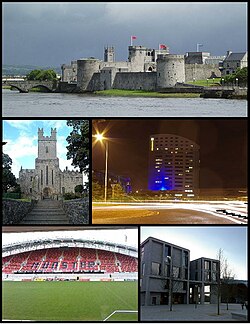 Montage of Limerick | |
| Location | |
| Location: | 52°39’55"N, 8°37’26"W |
| Data | |
| Population: | 91,456 |
| Dialling code: | 061 |
| Local Government | |
| Dáil constituency: |
Limerick City |
| Website: | www.LimerickCity.ie |
Limerick is a city on the estuary of the River Shannon. It is the county town of County Limerick.
The city is on the River Shannon, which made its fortune, and the most ancient part of the city located on King's Island bounded by the Shannon and Abbey rivers. Limerick is at the head of the Shannon Estuary where the river flows into the Atlantic Ocean. It is the third most populous city in the Irish Republic. In 2014, Limerick is to be designated Ireland's City of Culture, with a number of events due to take place in the city over the year.
Name
Though the name 'Limerick' may look Norse, and this was indeed a Norse kingdom for many generations, the name appears to be for the Irish language, Luimneach (ˈl̪imʲɨnʲəx)) for the older loimeanach meaning "bare marsh" or "bare place of the horses".
An earlier name appears in works of Ptolemy, who marked the place of King's Island as Regia.
Though the name Luimneach is ancient, it apparently marked only the shoreline hereabouts. The city was not founded until the Norse came here in the early ninth century and built a new town as a trading port and the centre of a kingdom. The Norse name was Hlymrek, from which the modern English name derives.
History
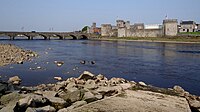
Ancient history
Luimneach originally referred to the general area along the banks of the Shannon Estuary known as Loch Luimnigh. The earliest settlement in the city, Inis Sibhtonn, was the original name for King's Island during the pre-Viking and Viking eras. This island was also called by the Irish Inis an Ghaill Duibh, meaning "The Dark Foreigner's Island" (Danes' Isle). Meanwhile, the Danes called it Hlymrekr.
The city dates from at least the Viking settlement in 812.
The Norse kings of Limerick were second only to those of Dublin. The first king is unknown, but the annals record their raiding parties on the Shannon. The last known Norse king of Limerick was Ivar of Limerick, who was defeated by the famous Brian Boru in the eleventh century. After his day the town formed a centre for the Kingdom of Thomond (North Munster). The last Irish king of Limerick was Domnall Mór Ua Briain, who burned the city to the ground in 1174 in a bid to keep it from the hands of the incoming Anglo-Normans, but in vain.
The English redesigned the city in the 12th century and added much of the most notable architecture, such as King John's Castle and St Mary's Cathedral.[1]
Late Renaissance/Early Modern history

During the civil wars of the 17th century the city played a pivotal role, besieged by Oliver Cromwell in 1651 and twice by the Williamites in the 1690s. The Treaty of Limerick ended the war in Ireland between supporters of the deposed, Roman Catholic King James II (the Jacobites) and the Protestant King William III (the Williamites). The treaty offered toleration to Roman Catholicism and full legal rights to papists who swore an oath of loyalty to William and Mary. The Treaty was of national significance as it ensured closer British and Protestant dominance over Ireland. The articles of the Treaty protecting Roman Catholic freedoms were not passed by the Protestant Irish Parliament but rather updated the Penal Laws against Romanists which had major implications for Irish history. Reputedly the Treaty was signed on the Treaty Stone, an irregular block of limestone which once served as a mounting block for horses. This stone is now displayed on a pedestal at Clancy Strand. Because of the treaty, Limerick is sometimes known as the Treaty City. This turbulent period earned the city its motto: Urbs antiqua fuit studisque asperrima belli ("An ancient city well studied in the arts of war").
The time of peace that followed the turmoil of the late 17th Century allowed the city to prosper through trade in the late 18th century. During this time Limerick Port established itself as one of Ireland's major commercial ports exporting agricultural produce from one of Ireland's most fertile areas, the Golden Vale to Britain and America.[2] This increase in trade and wealth saw a rapid expansion of the city as Limerick took on the appearance of a Georgian City. It was during this time that the city centre took on its present-day look including the extensive terraced streets of fine Georgian townhouses which remain in the city centre today.
The Waterford and Limerick Railway linked the city to the Dublin-Cork railway line in 1848 and to Waterford in 1853. The opening of a number of secondary railways in the subsequent decades developed Limerick as a regional centre of communications. However, the economic downturn in the European conflicts of the French Revolution and Napoleonic eras, and following the Act of Union 1800, and the impact of the Great Irish Famine of 1848 caused much of the 19th Century to be a more troubled period.
20th century history
During the Irish War of Independence, the Limerick Soviet was a self-declared soviet that existed from 15 to 27 April 1919. A general strike was organised by the Limerick Trades and Labour Council, as a protest against the British army's declaration of a "Special Military Area" under the Defence of the Realm Act, which covered most of Limerick city and a part of the county. During the strike a special strike committee was set up to print their own money, control food prices and publish newspapers.
By the mid-20th Century, Limerick was characterised by economic stagnation and decline as many traditional industries closed or left the city however there were some success stories. In 1942 Shannon International Airport (12 miles west of the city) opened for the first time offering transatlantic flights. In 1959, Shannon Airport enabled the opening of the Shannon Free Zone which attracted a large number of multinational companies to the region. A long campaign for a third level educational institute to be located in the city finally borne fruit with the establishment of a National Institute for Higher Education 'NIHE Limerick' in 1969 which eventually became the University of Limerick in 1989.
The Limerick poem
The city's name is much abused in the popular verse form, the limerick, a type of humorous verse of five lines with an AABBA rhyme scheme. The poem's connection with the city is obscure, but the name is generally taken to be a reference to Limerick city or County Limerick,[3] sometimes particularly to the Maigue Poets of Croom, County Limerick, and may derive from an earlier form of nonsense verse parlour game that traditionally included a refrain that included "Will [or won't] you come (up) to Limerick?"
The earliest known use of the name "Limerick" for this type poem is an 1880 reference, in a newspaper published in St John, New Brunswick, to an apparently well-known tune.[4]
Places of interest

Limerick City is a main tourist destination, only a 15-minute drive from Shannon Airport. Tourist attractions of architectural and historical note in the city centre include King John's Castle (1212), St Mary's Cathedral (1168), the Hunt Museum, the University of Limerick, Georgian houses and gardens and the Treaty Stone.
The city centre is divided between the traditional areas of "English Town" on the southern end of King's Island, which includes the King John's Castle; "Irish Town", which includes the older streets on the south bank; and the current economic centre further south, called Newtown Pery.[5] Newtown Pery was built in the late 18th century before the Act of Union and, unusually for an Irish city and unique in Limerick, is laid out on a grid plan. The Limerick City Museum (formerly known as the Jim Kemmy Municipal Museum), is next to King John's Castle. It contains displays on Limerick's history and manufactures.[6]


The Georgian core of the city, with fine Georgian architecture in the Newtown Pery, was developed from the mid 18th century. This core includes O'Connell Street (known as George Street before independence) from the Cecil Street intersection running to the south west end of the Crescent, and south-east to Pery Street including Glentworth Street and Barrington Street. Other architectural buildings of architectural note in the city are St John's Cathedral, designed by the notable Victorian architect, Philip Charles Hardwick. St Mary's Cathedral, at over 800 years old, is one of the oldest in Ireland. St John's Cathedral, whilst more modern, has Ireland's tallest spire at 308 feet.[7]
One of Ireland's most celebrated museums, the Hunt Museum, is based in the historic 18th-century former Custom House. The museum was established to house an internationally important collection of approximately 2000 works of art and antiquities formed by John and Gertrude Hunt during their lifetimes. On display are the 9th century Antrim Cross, a sketch by Picasso and a bronze sculpture of a horse, said to be from a design by Leonardo da Vinci.
The main park in Limerick is the People's Park which was opened in 1877 in memory of Richard Russell, a prominent local business man. The park is dominated by the Thomas Spring Rice memorial (MP for the city 1820-1832) and has a large collection of mature deciduous and evergreen trees.
Limerick city centre changed significantly with the construction of several modern high-rise buildings in the early 2000s, in particular as part of the regeneration of the former docks area along Docks Road. The suburban areas, where the majority of the population now live, have grown out from the centre along the main roads to Ennis (North Circular and Ennis Road areas/Caherdavin), Dublin (Castletroy and the University) and Cork (Ballinacurra/Dooradoyle/Raheen). Suburban houses are generally two floor semi-detached homes for single families. These were built from the 1950s onwards in large estates by government projects and commercial developments, although there are many examples of Edwardian and older 1930s suburban homes on the main suburban thoroughfares leading towards the city (North & South Circular, Ballinacurra Road, O'Connell Avenue).
Currently tourism is growing, with over 1,000 new beds being opened in the city in 2006 thanks to the opening of five new hotels. The city provides visitors with "Street Ambassadors", people designated to help others around and make their stay more enjoyable. Limerick City has a vibrant nightlife, with numerous nightclubs and pubssuch giving a range of drinking experiences from the warm and cosy to cutting edge. Dolan's Warehouse is a popular small concert venue that hosts many local, national and international folk, indie, jazz and rock acts. It is also an established venue for traditional Irish music.
In County Limerick, Adare village and the Foynes Flying Boat Museum, approximately 22 miles (or 30 minutes) from Limerick City along the scenic coastal N69 route from Limerick to Tralee, are also popular attractions.
Waterway transport
Transport on the River Shannon traditionally provided access from Limerick right up through the midlands of the country. The opening of the Grand Canal in the 18th century provided further access to Dublin and the east of the country.
Waterway transport on the Shannon was regularly used to transport goods from Limerick to Dublin and vice versa however this mode of transport fell into decline in the 20th century. Originally Limerick port was located near the confluence of the Abbey and Shannon rivers at King's Island. Today the port is located further downstream on the Shannon alongside the Dock Road and is operated by the Shannon Foynes Port Company who operate all marine activities in the Shannon estuary. It is a general purpose facility port. Plans to close the port and relocate all activity to the deepwater facility further downstream at Foynes have been abandoned. The plans included a major regeneration of the dockland area.
Pictures
-
King John's Castle on the River Shannon
-
Another view of King John's Castle
-
Sylvester O'Halloran Bridge
-
A view along the quay in Limerick City
-
The Treaty Stone on the banks of the River Shannon
-
Another view of the Treaty Stone
-
St Mary's Cathedral
-
St John's Cathedral
-
Limerick on the Shannon from Bishop's Quay
-
Limerick City and the River Shannon at sunset
Outside links
| ("Wikimedia Commons" has material about Limerick) |
- Limerick City Council
- Official Limerick City Website
- Various online history resources from Limerick City Library
- Architecture of Limerick
- Limerick City Museum
- Limerick Institute of Technology
- University of Limerick
- Film exploring Limerick regeneration
- Limerick's Life - History of Limerick
- Irish Rail Limerick Colbert Station Website
- Polski Limerick
References
- ↑ Hodkinson, Brian (2002). "The Topography of Pre-Norman Limerick". North Munster Antiquarian Journal 42: 1–6.
- ↑ http://www.libraryireland.com/topog/L/Limerick-Port.php
- ↑ Loomis 1963, pp. 153–157.
- ↑ reported by Stephen Goranson on the ADS-list and in comments at the Oxford Etymologist blog
- ↑ http://www.limerickcity.ie/Archives/LimerickCityStreetNamesGerryJoyce/Thefile,11411,en.pdf
- ↑ "LimerickCity.ie/CityMuseum". http://www.limerickcity.ie/CityMuseum/.
- ↑ "Limerick Diocesan Website". http://www.limerickdioceseheritage.org/StJohns/chStJohns.htm.
- The History of Limerick City by Sean Spellissy (1998)
- The Government and the People of Limerick. The History of Limerick Corporation/City Council 1197–2006 by Matthew Potter (2006)
- First Citizens of the Treaty City. The Mayors and Mayoralty of Limerick 1197–2007 by Matthew Potter (2007)
- The Memoirs of John M. Regan, a Catholic Officer in the RIC and RUC, 1909–48, Joost Augusteijn, editor, District Inspector, Limerick 1920, ISBN 978-1-84682-069-4.
| Cities in the Republic of Ireland |
|---|
